Thickness Effect on Photocatalytic Activity of TiO2 Thin Films Fabricated by Ultrasonic Spray Pyrolysis
Abstract
:1. Introduction
2. Results
2.1. Material Characterization
2.1.1. Surface Morphology
2.1.2. Structural Properties
2.1.3. Optical Properties
2.2. Photocatalytic Activity
3. Materials and Methods
3.1. Thin-Film Synthesis and Materials Characterization
3.2. Photocatalytic Measurements
4. Conclusions
Author Contributions
Funding
Conflicts of Interest
References
- Dedova, T.; Oja Acik, I.; Chen, Z.; Katerski, A.; Balmassov, K.; Gromyko, I.; Nagyne-Kovacs, T.; Szilagyi, I.M.; Krunks, M. Enhanced photocatalytic activity of ZnO nanorods by surface treatment with HAuCl4: Synergic effects through an electron scavenging, plasmon resonance and surface hydroxylation. Mater. Chem. Phys. 2020, 245, 122767. [Google Scholar] [CrossRef]
- Dundar, I.; Krichevskaya, M.; Katerski, A.; Oja Acik, I. TiO2 thin films by ultrasonic spray pyrolysis as photocatalytic material for air purification. R. Soc. Open Sci. 2019, 6, 181578. [Google Scholar] [CrossRef] [PubMed] [Green Version]
- Banerjee, S.; Dionysiou, D.D.; Pillai, S.C. Self-cleaning applications of TiO2 by photo-induced hydrophilicity and photocatalysis. Appl. Catal. B 2015, 176–177, 396–428. [Google Scholar] [CrossRef] [Green Version]
- Chen, J.; Poon, C. Photocatalytic construction and building materials: From fundamentals to applications. Build Environ. 2009, 44, 1899–1906. [Google Scholar] [CrossRef]
- Future Markets. Available online: www.futuremarketsinc.com/the-global-market-for-photocatalytic-nanocoatings (accessed on 22 July 2020).
- Daviðsdottira, S.; Shabadi, R.; Galcac, A.C.; Andersend, I.H.; Dirscherle, K.; Ambat, R. Investigation of DC magnetron-sputtered TiO2 coatings: Effect of coating thickness, structure, and morphology on photocatalytic activity. Appl. Surf. Sci. 2014, 313, 677–686. [Google Scholar] [CrossRef] [Green Version]
- Kenanakisa, G.; Vernardoua, D.; Dalamagkasa, A.; Katsarakis, N. Photocatalytic and electrooxidation properties of TiO2 thin films deposited by sol–gel. Catal. Today 2015, 240, 146–152. [Google Scholar] [CrossRef]
- Quici, N.; Vera, L.M.; Choi, H.; Puma, G.L.; Dionysiou, D.D.; Litter, I.M.; Destaillats, H. Effect of key parameters on the photocatalytic oxidation of toluene at low concentrations in air under 254 + 185 nm UV irradiation. Appl. Catal. B Environ. 2010, 95, 312–319. [Google Scholar] [CrossRef] [Green Version]
- Heikkilä, M.; Puukilainen, E.; Ritala, M.; Leskelä, M. Effect of thickness of ALD grown TiO2 films on photoelectrocatalysis. J. Photoch. Photobiol. A Chem. 2009, 204, 200–208. [Google Scholar] [CrossRef]
- Kääriäinen, M.-L.; Kääriäinen, T.O.; Cameron, D.C. Titanium dioxide thin films, their structure and its effect on their photoactivity and photocatalytic properties. Thin Solid Films 2009, 517, 6666–6670. [Google Scholar] [CrossRef]
- Guillén, C.; Herrero, J. TiO2 coatings obtained by reactive sputtering at room temperature: Physical properties as a function of the sputtering pressure and film thickness. Thin Solid Films 2017, 636, 193–199. [Google Scholar] [CrossRef]
- Sheng, J.; Karasawa, J.; Fukami, T. Thickness dependence of photocatalytic activity of anatase film by magnetron sputtering. J. Mater. Sci. 1997, 16, 1709–1711. [Google Scholar]
- Marcello, A.B.; Correa, V.O.; Bento, T.R.; Pillis, F.M. Effect of growth parameters on the photocatalytic performance of TiO2 films prepared by MOCVD. J. Braz. Chem. Soc. 2020, 31, 1270–1283. [Google Scholar] [CrossRef]
- Jung, S.; Kim, S.; Imaishi, N.; Cho, Y. Effect of TiO2 thin film thickness and specific surface area by low-pressure metal–organic chemical vapor deposition on photocatalytic activities. Appl. Catal. B Environ. 2005, 55, 253–257. [Google Scholar] [CrossRef]
- Yu, J.; Zhao, X.; Zhao, Q. Effect of film thickness on the grain size and photocatalytic activity of the sol-gel derived nanometer TiO2 thin films. J. Mater. Sci. 2000, 19, 1015–1017. [Google Scholar]
- Tada, H.; Tanaka, M. Dependence of TiO2 photocatalytic activity upon its film thickness. Langmuir 1997, 13, 360–364. [Google Scholar] [CrossRef]
- Wu, C.; Lee, Y.; Lo, Y.; Lin, C.; Wu, C. Thickness-dependent photocatalytic performance of nanocrystalline TiO2 thin films prepared by sol–gel spin coating. Appl. Surf. Sci. 2013, 280, 737–744. [Google Scholar] [CrossRef]
- Blanco, E.; Gonzalez-Leal, M.J.; Solar, R. Photocatalytic TiO2 sol–gel thin films: Optical and morphological characterization. Sol. Energy 2015, 122, 11–23. [Google Scholar] [CrossRef]
- Xianyu, X.W.; Park, K.M.; Lee, I.W. Thickness effect in the photocatalytic activity of TiO2 thin films derived from sol-gel process. Korean Chem. Eng. 2001, 18, 903–907. [Google Scholar] [CrossRef]
- Spiridonova, J.; Katerski, A.; Danilson, M.; Krichevskaya, M.; Krunks, M.; Oja Acik, I. Effect of the titanium isopropoxide: Acetylacetone molar ratio on the photocatalytic activity of TiO2 thin films. Molecules 2019, 24, 4326. [Google Scholar] [CrossRef] [Green Version]
- Perednis, D.; Gauckler, G.L. Thin film deposition using spray pyrolysis. J. Electroceram. 2005, 14, 103–111. [Google Scholar] [CrossRef]
- Nakaruk, A.; Sorrell, C.C. Conceptual model for spray pyrolysis mechanism: Fabrication and annealing of titania thin films. J. Coat. Technol. Res. 2010, 7, 665–676. [Google Scholar] [CrossRef]
- Oja, I.; Mere, A.; Krunks, M.; Nisuma, R.; Solterbeck, C.-H.; Es-Sounic, M. Structural and electrical characterization of TiO2 films grown by spray pyrolysis. Thin Solid Films 2006, 515, 664–677. [Google Scholar] [CrossRef]
- Dundar, I.; Krichevskaya, M.; Katerski, A.; Krunks, M.; Oja Acik, I. Photocatalytic degradation of different VOCs in the gas-phase over TiO2 thin films prepared by ultrasonic spray pyrolysis. Catalysts 2019, 9, 915. [Google Scholar] [CrossRef] [Green Version]
- Spalatu, N.; Hiie, J.; Kaupmees, R.; Volobujeva, O.; Krustok, J.; Oja Acik, I.; Krunks, M. Postdeposition processing of sns thin films and solar cells: Prospective strategy to obtain large, sintered, and doped SnS grains by recrystallization in the presence of a metal halide flux. ACS Appl. Mater. Interfaces 2019, 11, 17539–17554. [Google Scholar] [CrossRef] [PubMed]
- Spalatu, N.; Krunks, M.; Hiie, J. Structural and optoelectronic properties of CdCl2 activated CdTe thin films modified by multiple thermal annealing. Thin Solid Films 2017, 633, 106–111. [Google Scholar] [CrossRef]
- Vahl, A.; Veziroglu, S.; Henkel, B.; Strunskus, T.; Polonskyi, O.; Aktas, C.O.; Faupel, F. Pathways to tailor photocatalytic performance of TiO2 thin films deposited by reactive magnetron sputtering. Materials 2019, 12, 2840. [Google Scholar] [CrossRef] [PubMed] [Green Version]
- Yazid, A.S.; Rosli, M.Z.; Juoi, M.J. Effect of titanium (IV) isopropoxide molarity on the crystallinity and photocatalytic activity of titanium dioxide thin film deposited via green sol–gel route. J. Mater. Res. Technol. 2019, 8, 1434–1439. [Google Scholar] [CrossRef]
- Oja Acik, I.; Junolainen, A.; Mikli, V.; Danilson, M.; Krunks, M. Growth of ultra-thin TiO2 films by spray pyrolysis on different substrates. Appl. Surf. Sci. 2009, 256, 1391–1394. [Google Scholar] [CrossRef]
- Oja Acik, I.; Mere, A.; Krunks, M.; Solterbeck, C.H.; Es-Souini, M. Properties of TiO2 films prepared by the spray pyrolysis method. Solid State Phenom. 2004, 99, 259–264. [Google Scholar]
- Rauta, N.C.; Mathewsa, T.; Chandramohan, P.; Srinivasan, M.P.; Dasha, S.; Tyagi, A.K. Effect of temperature on the growth of TiO2 thin films synthesized by spray pyrolysis: Structural, compositional and optical properties. Mater. Res. Bull. 2011, 46, 2057–2063. [Google Scholar] [CrossRef]
- Deshmukh, H.P.; Shinde, P.S.; Patil, P.S. Structural, optical and electrical characterization of spray deposited TiO2 thin films. Mater. Sci. Eng. B 2006, 130, 220–227. [Google Scholar] [CrossRef]
- Paz, Y.; Luo, Z. Photooxidative self-cleaning transparent titanium dioxide films on glass. J. Mater. Res. 1995, 10, 2842–2848. [Google Scholar] [CrossRef]
- Mills, A.; Lepre, A.; Elliott, N.; Bhopal, S.; Parkin, P.I.; O’Neill, S.A. Characterisation of the photocatalyst Pilkington Activ TM a reference film photocatalyst? J. Photoch. Photobiol. A. Chem. 2003, 160, 213–224. [Google Scholar] [CrossRef]
- Smirnova, N.; Fesenko, T.; Zhukovsky, M.; Goworek, J.; Eremenko, A. Photodegradation of Stearic Acid Adsorbed on Superhydrophilic TiO2 Surface: In Situ FTIR and LDI Study. Nanoscale Res. Lett. 2015, 10, 7. [Google Scholar] [CrossRef] [Green Version]
- Kumar, J.K.; Raju, R.C.N.; Subrahmanyam, A. Thickness dependent physical and photocatalytic properties of ITO thin films prepared by reactive DC magnetron sputtering. Appl. Surf. Sci. 2011, 257, 3075–3080. [Google Scholar] [CrossRef]
- Cedillo-Gonzalez, I.E.; Hernandez-Lopez, M.J.; Ruiz-Valdez, J.J.; Barbieri, V.; Siligardi, C. Self-cleaning TiO2 coatings for building materials: The influence of morphology and humidity in the stain removal performance. Constr. Build. Mater. 2020, 237, 117692. [Google Scholar] [CrossRef]



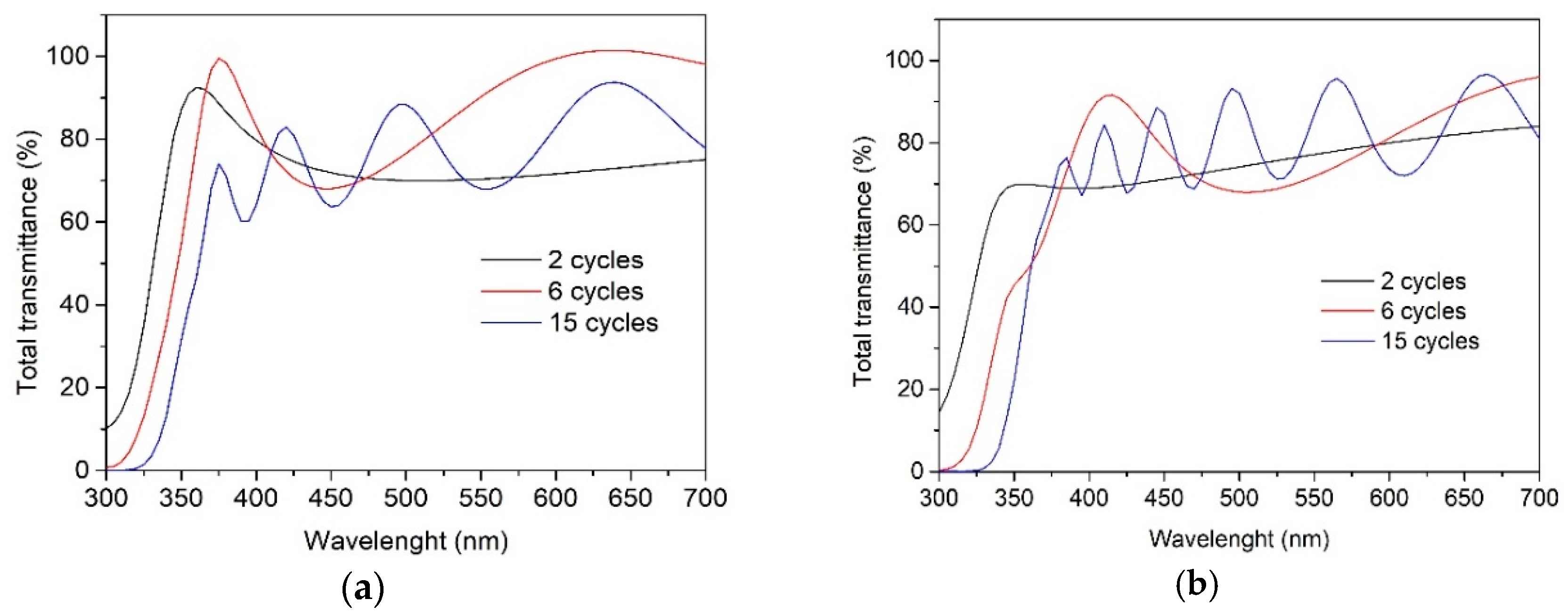
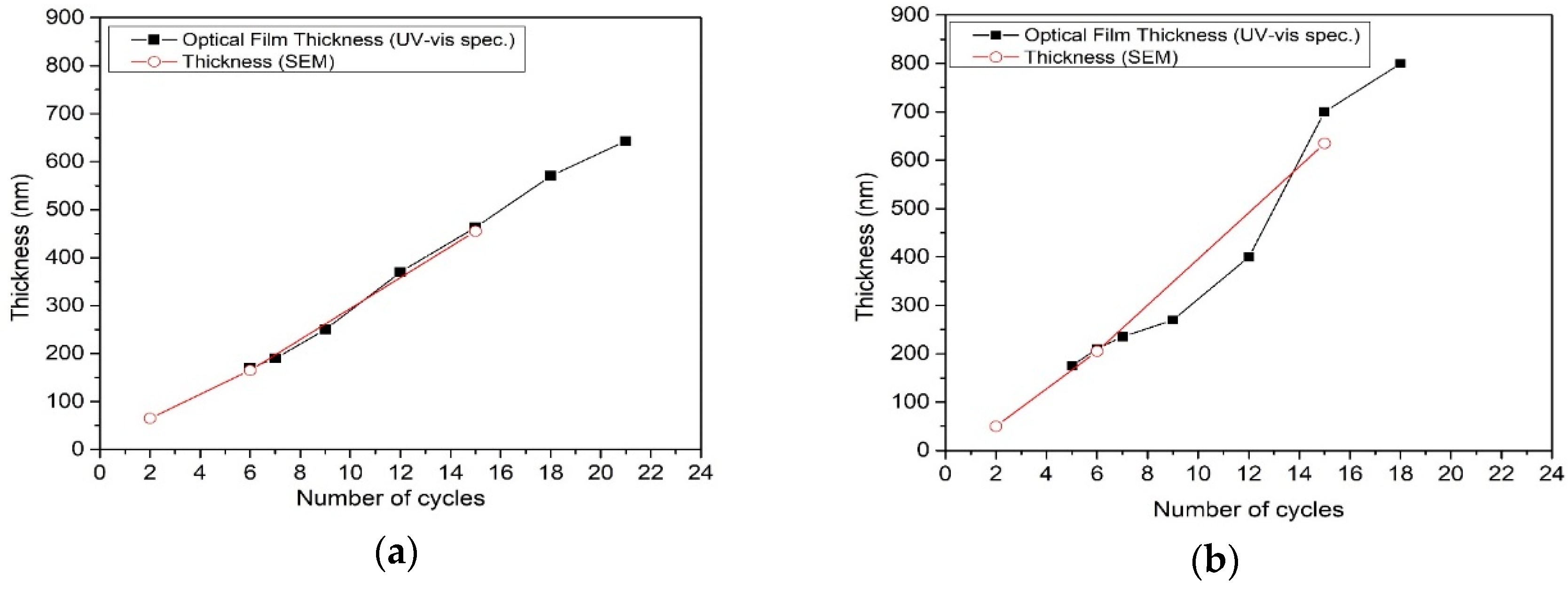
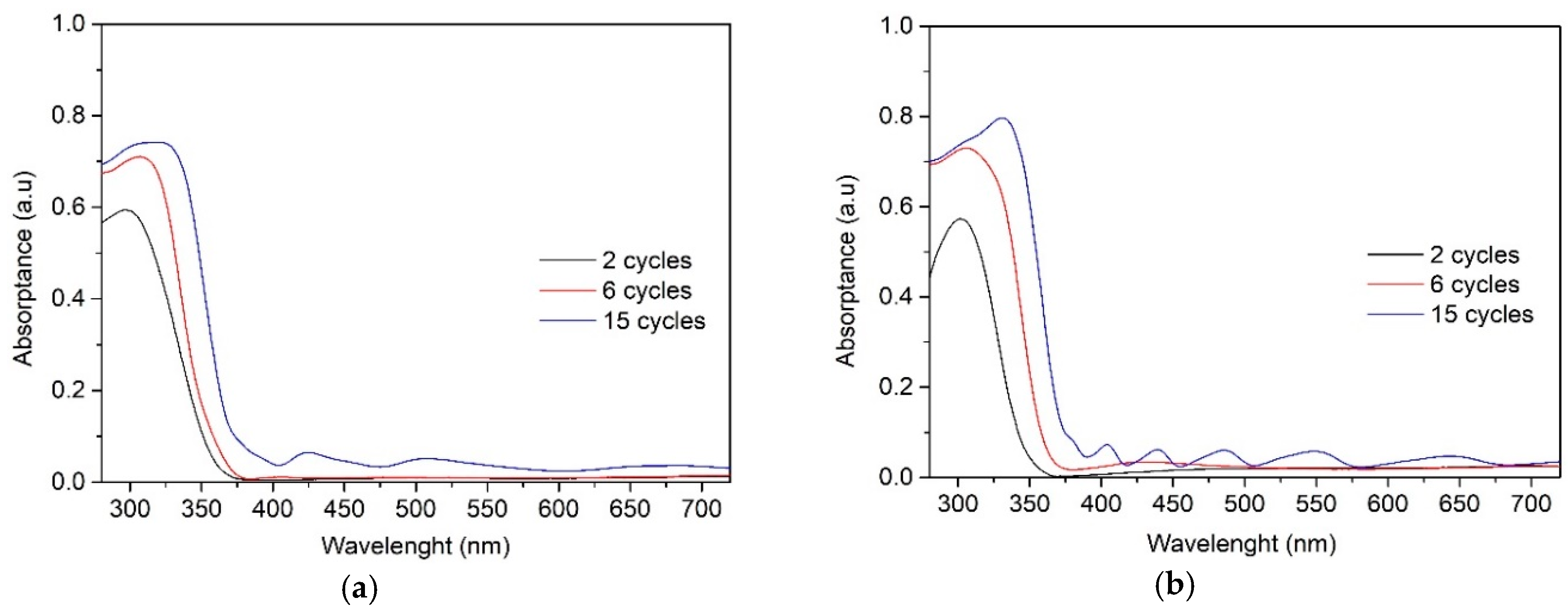
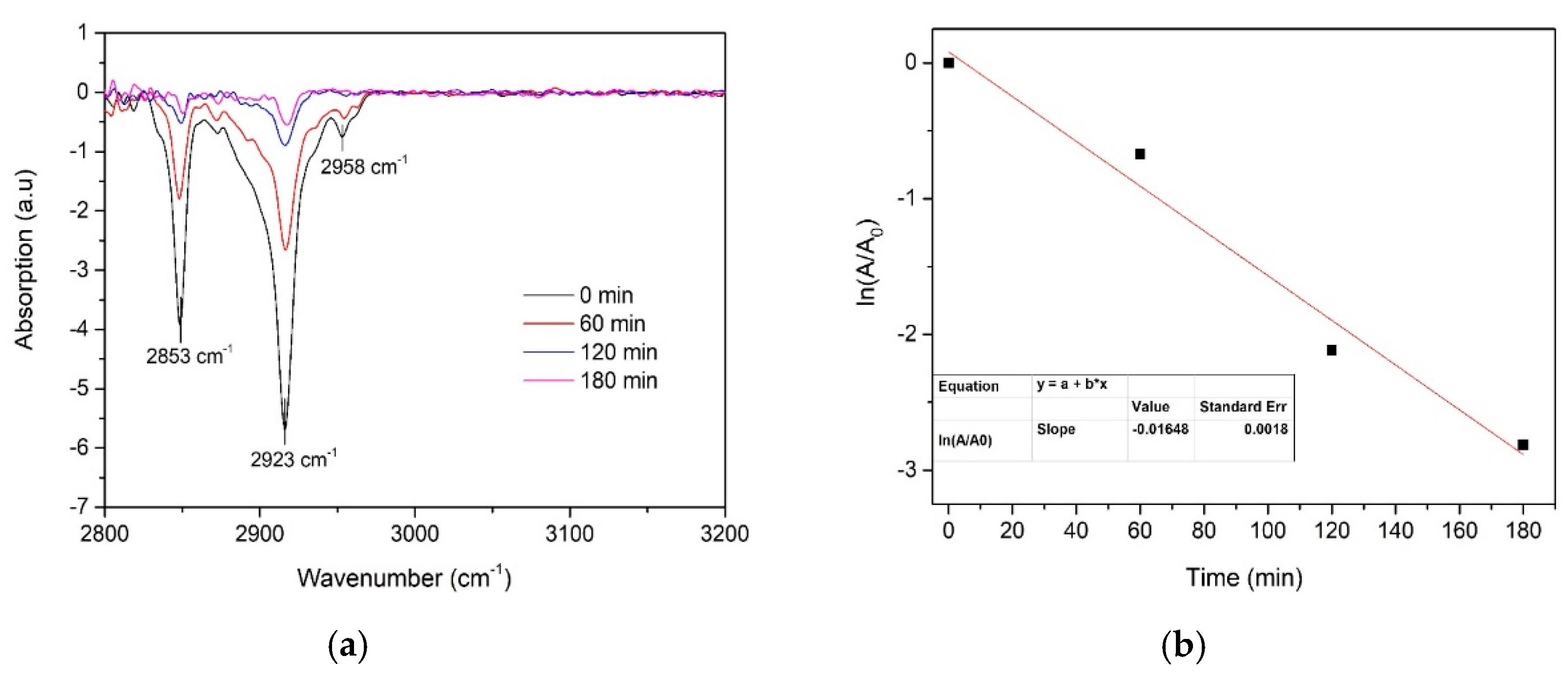
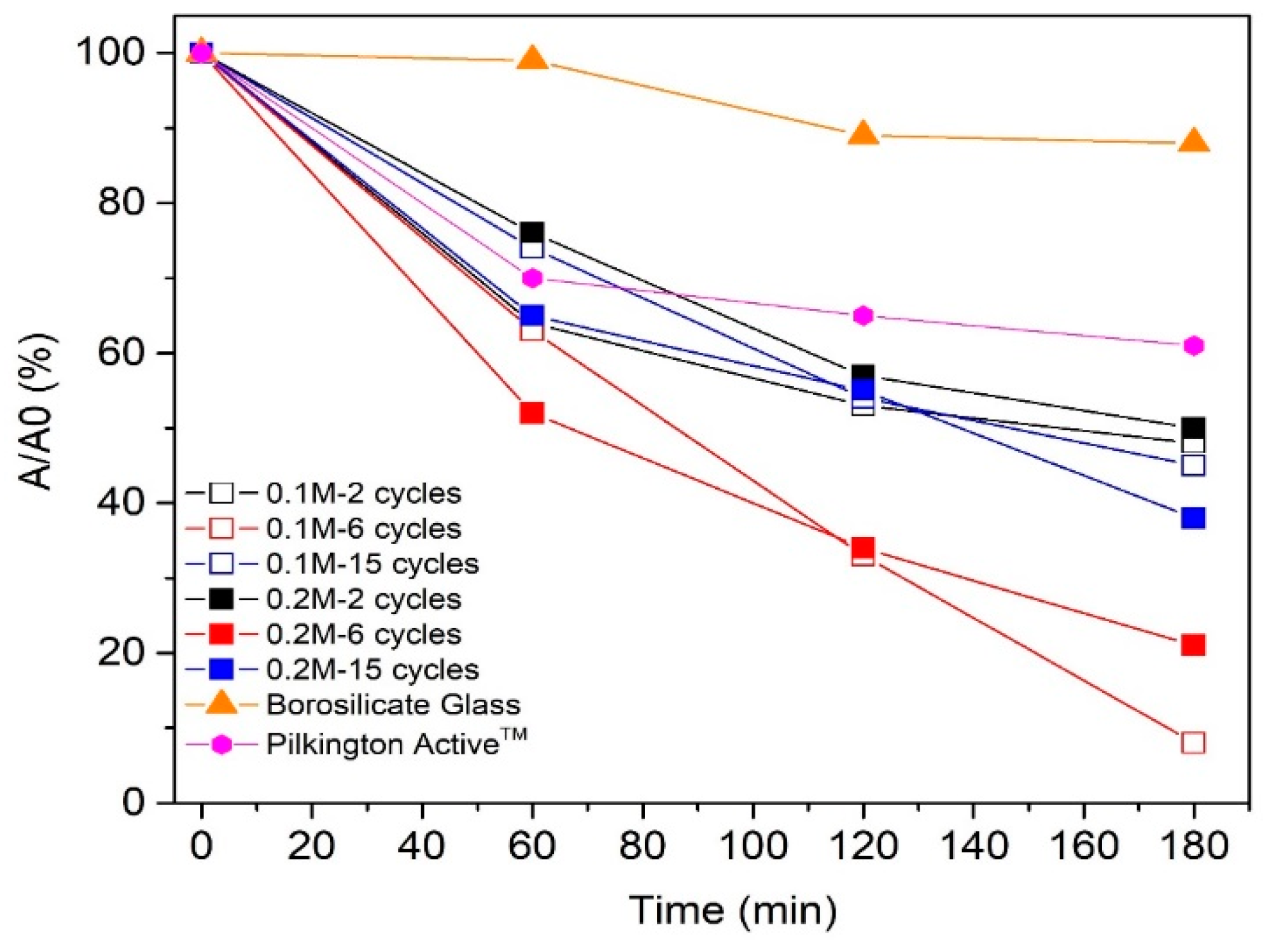

| Cycle No. | TTIP Concentration in Solution (M) | Deposition Time (min) | Deposition Rate (nm min−1) | Thickness (nm)/SEM | RMS (nm)/AFM | Mean Crystallite Size (nm)/XRD |
|---|---|---|---|---|---|---|
| 2 | 0.1 | 2.9 | 22.4 | 65 | 1.60 | 30 |
| 6 | 0.1 | 8.7 | 19.0 | 170 | 1.60 | 45 |
| 15 | 0.1 | 21.75 | 20.9 | 455 | 2.60 | 50 |
| 2 | 0.2 | 2.9 | 17.2 | 50 | 0.80 | 25 |
| 6 | 0.2 | 8.7 | 23.6 | 205 | 1.10 | 35 |
| 15 | 0.2 | 21.75 | 29.2 | 635 | 1.60 | 40 |
© 2020 by the authors. Licensee MDPI, Basel, Switzerland. This article is an open access article distributed under the terms and conditions of the Creative Commons Attribution (CC BY) license (http://creativecommons.org/licenses/by/4.0/).
Share and Cite
Dundar, I.; Mere, A.; Mikli, V.; Krunks, M.; Oja Acik, I. Thickness Effect on Photocatalytic Activity of TiO2 Thin Films Fabricated by Ultrasonic Spray Pyrolysis. Catalysts 2020, 10, 1058. https://doi.org/10.3390/catal10091058
Dundar I, Mere A, Mikli V, Krunks M, Oja Acik I. Thickness Effect on Photocatalytic Activity of TiO2 Thin Films Fabricated by Ultrasonic Spray Pyrolysis. Catalysts. 2020; 10(9):1058. https://doi.org/10.3390/catal10091058
Chicago/Turabian StyleDundar, Ibrahim, Arvo Mere, Valdek Mikli, Malle Krunks, and Ilona Oja Acik. 2020. "Thickness Effect on Photocatalytic Activity of TiO2 Thin Films Fabricated by Ultrasonic Spray Pyrolysis" Catalysts 10, no. 9: 1058. https://doi.org/10.3390/catal10091058
APA StyleDundar, I., Mere, A., Mikli, V., Krunks, M., & Oja Acik, I. (2020). Thickness Effect on Photocatalytic Activity of TiO2 Thin Films Fabricated by Ultrasonic Spray Pyrolysis. Catalysts, 10(9), 1058. https://doi.org/10.3390/catal10091058







